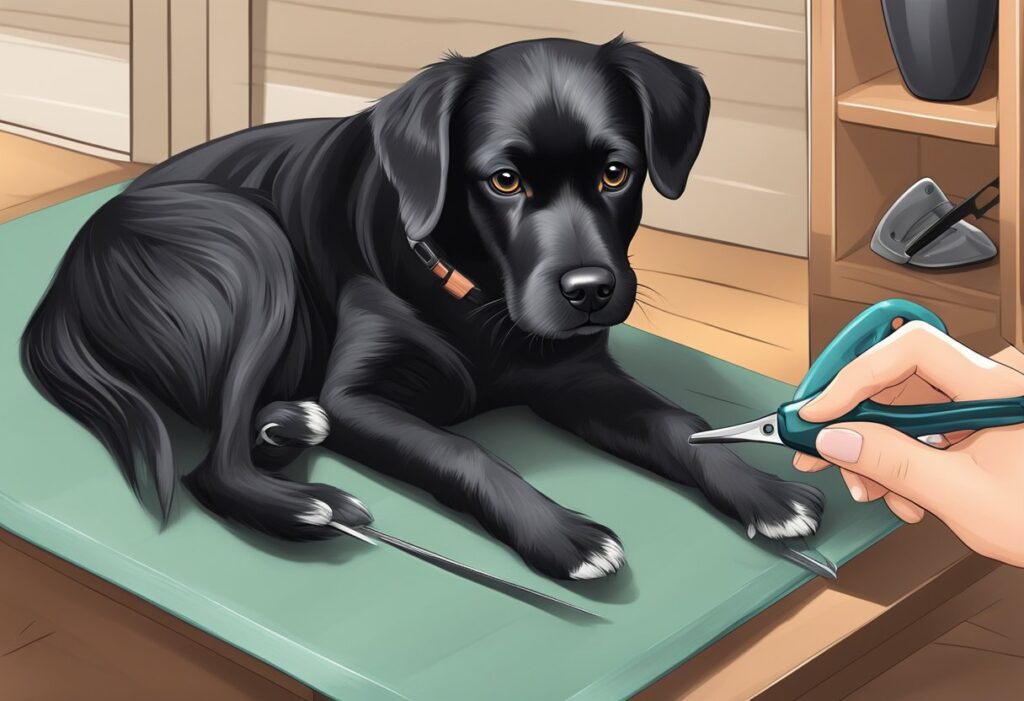Cutting your dog’s nails can be a daunting task, especially if your dog has black nails. It can be difficult to see where the quick (the blood vessel inside the nail) ends and the nail begins. However, it is important to keep your dog’s nails trimmed to prevent discomfort and potential injury.

Fortunately, with the right technique and tools, cutting your dog’s black nails can be done safely and efficiently. In this article, we will guide you through the process of trimming your dog’s nails, specifically focusing on black nails. We will cover the tools you will need, the technique for cutting black nails, and tips for keeping your dog calm during the process. By the end of this article, you will feel confident in your ability to trim your dog’s black nails.
Preparing Your Dog for Nail Trimming
Trimming your dog’s black nails can be a daunting task, but with some preparation and the right tools, it can be a stress-free experience for both you and your furry friend. In this section, we’ll cover some tips on how to prepare your dog for nail trimming.
Getting Your Dog Comfortable
Before you start trimming your dog’s nails, it’s important to make sure they are comfortable and relaxed. You can do this by spending some time petting and massaging your dog’s paws. This will help them get used to having their paws touched and will make the nail trimming process less stressful for them.
Another way to get your dog comfortable is by offering them treats. Treats are a great way to reward your dog for good behavior and can help distract them while you trim their nails. You can also use positive reinforcement techniques, such as giving your dog verbal praise or a belly rub, to let them know they’re doing a good job.
Choosing the Right Tools
Choosing the right tools for nail trimming is crucial to ensure a safe and effective trimming experience. There are several options available, including nail clippers, grinders, and dog nail trimmers.
Nail clippers are a popular option and come in different sizes and styles. It’s important to choose a clipper that is the right size for your dog’s nails. Clippers that are too small can cause discomfort, while clippers that are too big can be difficult to handle.
Grinders are another option and are great for dogs with thick nails. They work by grinding down the nail, rather than cutting it. Grinders can be a bit more expensive than clippers, but they are a good investment if you have a dog with thick nails.
Dog nail trimmers are a newer option and are designed specifically for trimming dog nails. They come in different sizes and styles and are easy to use. They are also a good option if you’re not comfortable using clippers or grinders.
In conclusion, preparing your dog for nail trimming is an important step in ensuring a stress-free trimming experience. By getting your dog comfortable and choosing the right tools, you can make the process easier and safer for both you and your furry friend.
Identifying the Quick in Black Dog Nails
Trimming your dog’s nails can be a tricky task, especially if your dog has black nails. One of the most important things to consider before trimming your dog’s nails is to identify the quick. The quick is a blood vessel and nerve that runs through the center of your dog’s nail. Cutting the quick can cause pain and bleeding, so it’s important to identify it before trimming your dog’s nails.
Understanding Nail Anatomy
Before identifying the quick, it’s important to understand the anatomy of your dog’s nail. A dog’s nail is made up of the nail bed, which is the skin underneath the nail, and the nail itself, which is made up of hard keratin. The quick is located in the center of the nail and is surrounded by nerves and blood vessels. In black nails, the quick may be harder to see, but it’s still present.
Using Visual Aids to Find the Quick
One of the best ways to identify the quick in black dog nails is by using a flashlight. Shine the flashlight underneath your dog’s nail and look for a dark mass inside the nail. This dark mass is the quick. If your dog’s nails are thin enough, you may be able to see the quick as a shadowed area.
Another way to identify the quick is by looking at the base of the nail. The quick will appear as a pinkish area at the base of the nail. This is where the blood vessels and nerves enter the nail. If you’re unsure about where the quick is located, it’s always better to err on the side of caution and only trim a small amount of the nail at a time.
In conclusion, identifying the quick in black dog nails is an important step in trimming your dog’s nails. Understanding the anatomy of your dog’s nail and using visual aids such as a flashlight can help you locate the quick and avoid cutting it. Remember to always trim your dog’s nails in a well-lit area and take your time to ensure that you don’t cut the quick.
The Trimming Process
Trimming your dog’s black nails can be a daunting task, but with the right tools and technique, it can be done safely and effectively. Here are the steps to follow:
Trimming with Clippers
- Hold your dog’s paw firmly but gently to help stabilize the nail and reduce the risk of cutting too deep or trimming at the wrong angle.
- Position the clippers so that you cut the nail from top to bottom, not side to side. This will help prevent accidental cuts or damage to the nail bed.
- Apply pressure to the clippers to make a clean cut. If you accidentally cut too deep and hit the quick, use a styptic powder or cornstarch to stop the bleeding.
Using a Nail Grinder
- Hold your dog’s paw firmly but gently to help stabilize the nail and reduce the risk of cutting too deep or trimming at the wrong angle.
- Turn on the nail grinder and gently touch it to the nail, grinding away small amounts at a time. Be sure to avoid the quick, which is the pink part of the nail that contains blood vessels and nerves.
- Use a nail file to smooth out any rough edges.
Smoothing the Edges
- Use a nail file to smooth out any rough edges after trimming or grinding your dog’s nails. This will help prevent your dog’s nails from snagging on carpet or furniture.
- Hold the nail file at a 45-degree angle to the nail and file in one direction. Be sure to file the edges of the nail as well as the top.
- Reward your dog with a treat and praise for being patient during the nail trimming process.
Remember to take your time and be patient when trimming your dog’s nails. If you’re unsure about how to trim your dog’s nails, consult with a veterinarian or professional dog groomer.
Handling Accidents and Bleeding
Cutting a dog’s black nails can be a bit tricky, and accidents can happen. If you cut the quick, which is the pink part inside the nail that contains blood vessels and nerves, your dog may bleed. Although it may seem alarming, bleeding can usually be stopped quickly with the right tools and techniques.
Using Styptic Powder
Styptic powder is a clotting agent that helps stop bleeding. It is a must-have item in your dog’s first aid kit. If you accidentally cut the quick, apply some styptic powder to the nail. Dip the bleeding nail into the powder or use a cotton swab to apply the powder directly to the nail. The powder will help stop the bleeding by constricting the blood vessels.
If you don’t have any styptic powder on hand, you can use flour or cornstarch as a substitute. These household items work the same way as styptic powder to help stop bleeding.
When to See a Vet
If your dog’s nail continues to bleed after applying styptic powder or a clotting agent, it may be a sign of a more serious injury. In some cases, a dog may need stitches or antibiotics to prevent infection. If you are unsure or uncomfortable with treating your dog’s injury, it is best to seek veterinary care.
In addition, if you notice signs of infection, such as redness, swelling, or discharge from the nail, it is important to seek veterinary care. Infections can spread quickly and cause serious health problems if left untreated.
Remember, accidents can happen when cutting your dog’s nails, but with the right tools and techniques, you can handle them quickly and effectively.
Aftercare and Ongoing Maintenance
Cutting your dog’s black nails can be a stressful experience for both you and your furry friend. However, with patience and confidence, you can successfully trim your dog’s nails without causing any harm. After the nail trimming session, it’s essential to provide your dog with proper aftercare and ongoing maintenance.
Checking for Signs of Stress
After trimming your dog’s nails, it’s crucial to check for any signs of stress. Some common signs of stress in dogs include panting, drooling, shaking, and avoiding eye contact. If you notice any of these signs, it’s essential to provide your dog with some comfort and reassurance. You can offer your dog some treats or a favorite toy to help them relax.
Scheduling Regular Trimmings
To maintain your dog’s nail health, it’s essential to schedule regular trimmings. The frequency of trimming can vary depending on your dog’s activity level, breed, and nail growth rate. Generally, it’s recommended to trim your dog’s nails every 3-4 weeks. However, some dogs may require more frequent trimmings, while others may need less.
During the ongoing maintenance, you can also monitor your dog’s nail growth and length. If you notice that your dog’s nails are getting too long, it’s time to schedule a trimming session. Long nails can cause discomfort and pain to your dog and even lead to health problems like joint pain and posture issues.
In conclusion, aftercare and ongoing maintenance are crucial aspects of dog nail care. By checking for signs of stress and scheduling regular trimmings, you can ensure your dog’s nail health and overall well-being. Remember to approach nail trimming with patience and confidence, and don’t forget to reward your dog with some treats and praise for their cooperation.
